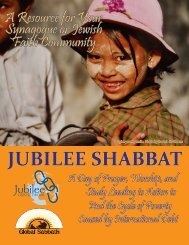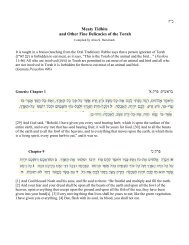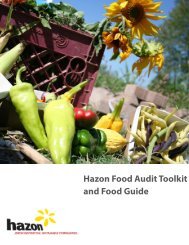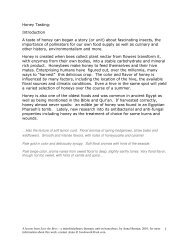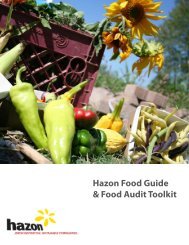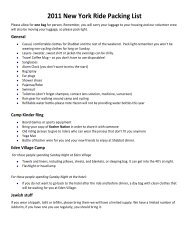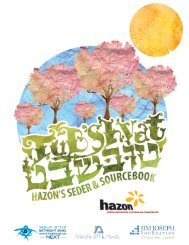Download Chapter 6 of the Food Guide. - Hazon
Download Chapter 6 of the Food Guide. - Hazon
Download Chapter 6 of the Food Guide. - Hazon
Create successful ePaper yourself
Turn your PDF publications into a flip-book with our unique Google optimized e-Paper software.
6Community Agriculture andGardensThe increasing popularity <strong>of</strong> Jewish gardens and Community Supported Agriculture (CSA)projects makes it even easier to bring healthy food and awareness <strong>of</strong> local food and farmingissues to your synagogue, community center, or institution. <strong>Hazon</strong>’s food work began with <strong>the</strong>launch <strong>of</strong> <strong>the</strong> first ever Jewish CSA in 2004. Since <strong>the</strong>n, <strong>the</strong> <strong>Hazon</strong> CSA program has expandedto include over 50 sites across <strong>the</strong> US, Canada, and Israel. We’ve seen firsthand how a CSA canbring a community toge<strong>the</strong>r, inspire new programs and learning, and have a very real effecton supporting sustainable agriculture. Collectively, <strong>Hazon</strong> CSAs have put nearly $5 million inJewish purchasing power behind sustainable agriculture since 2004.If you want to go beyond a CSA, what better place to learn about <strong>the</strong> miracles <strong>of</strong> growingfood than in a garden where you can actually watch <strong>the</strong> process happen? People <strong>of</strong> all agescan learn something new in a garden, finding joy and intrigue in <strong>the</strong> unfolding drama <strong>of</strong>growing plants. A garden at your institution can connect your community to <strong>the</strong> growingcycle. It can also, if it’s big enough, grow enough food to feed you, or perhaps even supply asoup kitchen in your area. And it can become a living laboratory where you can learn aboutJewish agricultural laws and food blessings with an entirely fresh perspective.This section uses material from <strong>the</strong> Jewish Farm School’s Jewish Gardening Workshop fromJune 2009. <strong>Download</strong> <strong>the</strong> entire document at hazon.org/foodguide/ch9
Start a <strong>Hazon</strong> CSA!<strong>Hazon</strong>’s CSA program is <strong>the</strong> first ongoing effort in<strong>the</strong> American Jewish community to support local,sustainable agriculture. Founded in 2004, our CSAprogram now includes over fifty CSAs in <strong>the</strong> US, Canada,and Israel, and over 2,300 households. The <strong>Hazon</strong> CSAprogram has helped <strong>the</strong> Jewish community to put over$4.5 million dollars behind sustainable agriculture andsupported Jewish institutions such as synagogues andJCCs to create innovative educational programmingaround <strong>the</strong> intersections <strong>of</strong> Jewish tradition andcontemporary food and environmental issues.<strong>Hazon</strong>’s CSA program will help you through your firstyear <strong>of</strong> planning, marketing, organizing, and runningyour CSA project. We’ll also help you create engaging,high-quality adult and family Jewish education aroundfood and agriculture.“I have struggled connecting with <strong>the</strong> Jewish communitybecause I have not found myself in it. Joining a Jewish CSAwas a great way for me to connect my Jewish identity withthings I am passionate about, such as food politics andsustainable living. I am glad that <strong>the</strong> Jewish communityrecognizes that food issues are Jewish issues. Thank you forcreating a space in which people like me who struggle withconnecting to <strong>the</strong> Jewish community can feel welcome andinvited.”Esty, Brooklyn NYHost a Farmers’ MarketA farmers’ market is a great way to support localfarms, as well as give your community easy access towonderful, fresh produce. You may want to invite afew farmers or local vendors to an event you’re alreadyplanning (i.e. Sukkot fair, Lag B’omer picnic) or set up aweekly or monthly market. Make sure you think aboutwhat kind <strong>of</strong> traffic you’ll have— you want to make sureyour vendors sell enough to make it worth <strong>the</strong>ir time!For suggestions on starting a farmers’ market, includingsignage, management, by-laws, budgets, and fees, visit:http://www.organic-growers.com/start_a_farmers_market_1.htmStart a Jewish GardenGardening is an activity that can rejuvenate Judaismand Jews on many levels. For one, gardening servesto reconnect <strong>the</strong> Jewish spirit to <strong>the</strong> earth. Twothousand years <strong>of</strong> Jewish urbanization has forged anestrangement from nature that reaches to <strong>the</strong> core <strong>of</strong><strong>the</strong> Jewish psyche. Gardening restores familiarity withour local ecologies and deepens our understanding <strong>of</strong>where our food comes from. Even more consequential,intimacy with nature deepens <strong>the</strong> Jewish sense <strong>of</strong>wonder and heightens our consciousness <strong>of</strong> God’scountless miracles.This sense <strong>of</strong> wonder, <strong>the</strong> sensitivity to <strong>the</strong> web <strong>of</strong> lifethat supports us both physically and spiritually, is anintegral aspect <strong>of</strong> Jewish consciousness and thus aprerequisite for Jewish living. The famous verse fromBreishit 2:15 states, “And <strong>the</strong> Lord God took <strong>the</strong> manand placed him in <strong>the</strong> Garden <strong>of</strong> Eden, to till it and totend it.” The Torah’s notion <strong>of</strong> human responsibility tosteward <strong>the</strong> earth, as well as <strong>the</strong> rest <strong>of</strong> our tradition’srich collection <strong>of</strong> teachings concerning <strong>the</strong> relationshipbetween humanity and <strong>the</strong> natural world, becomeirrelevant and, even more, incomprehensible to <strong>the</strong> Jewwho is not in relation to nature. Jews must reacquaint<strong>the</strong>mselves with <strong>the</strong> earth. Gardening suits such anoble and formidable task. There is little else thatreminds a person <strong>of</strong> <strong>the</strong> feeling and smell <strong>of</strong> naturequite like placing one’s hands directly in <strong>the</strong> earth.Gardening reawakens our dulled senses to <strong>the</strong> lifeblood<strong>of</strong> our planet.The Jewish connection to <strong>the</strong> earth emerges from ourpeople’s agricultural roots. As we cut Judaism <strong>of</strong>f fromits own heritage, we in turn lose our connection to ouragricultural history and <strong>the</strong> ecological <strong>the</strong>mes in ourholidays. For example, <strong>the</strong> agricultural <strong>the</strong>mes inherentduring <strong>the</strong> growing and harvest season from TuB’Shvat, <strong>the</strong> beginning <strong>of</strong> <strong>the</strong> budding <strong>of</strong> trees throughSukkot, <strong>the</strong> final harvest, lose <strong>the</strong>ir meaning withoutour continued intimacy with <strong>the</strong> cycles <strong>of</strong> nature. Byreconnecting with <strong>the</strong> natural world through gardeningwe allow <strong>the</strong>se aspects <strong>of</strong> our tradition to speak to us innew ways and to bring greater meaning to our lives.Finally, gardening can also be used to bring Jewishtext to life. Even for Jews for whom <strong>the</strong> world <strong>of</strong>Jewish texts is already familiar and accessible, Jewishgardening <strong>of</strong>fers us rich opportunities for opening up<strong>the</strong> world <strong>of</strong> <strong>the</strong> Torah, Rabbinic texts, and <strong>the</strong> siddur toin new, vibrant, and creative ways.<strong>Hazon</strong> <strong>Food</strong> <strong>Guide</strong>41
Themes for Your Jewish GardenWhile a garden lends itself to all kinds <strong>of</strong> differentprograms, you may wish to create a garden that has aspecific focus or educational goal. Here are a couplesuggestions, with program ideas:A Garden for Jewish Rituals: Havdalah. A Havdalahgarden consists <strong>of</strong> plants that can be used for <strong>the</strong>Havdalah ceremony and allows gardeners to connect <strong>the</strong>act <strong>of</strong> gardening with religious practice. Not only does itgive a deep and spiritual framework for <strong>the</strong> physical labor,it can also foster a deeper connection to <strong>the</strong> Jewish ritual.One major advantage <strong>of</strong> a Havdalah garden is that manyfragrant herbs, such as lavender, sage, mint, rosemary,thyme, marjoram, are hardy perennials and will comeback year after year. Additionally, <strong>the</strong>se plants will growmore robust with <strong>the</strong> weekly harvesting <strong>of</strong> leaves forHavdalah.Program suggestions:Dry herbs and make Havdalah kitsMake Havdalah in <strong>the</strong> gardenLearn <strong>the</strong> brachot (blessings) related to smellIsrael and Biblical Gardens. Many people are interestedin biblical plants. A biblical or Israel garden can serve asa great tool when teaching about Israel, both ancient andmodern. Seeing <strong>the</strong> numerous plants that are mentionedin <strong>the</strong> Torah can really help young gardeners connectwith <strong>the</strong> sometimes distant text. The plants you grow inan Israel garden can be limited to <strong>the</strong> seven species, oryou could expand it to include as many biblical plants asyou can find and grow.Program suggestions:Tour <strong>of</strong> Israel through <strong>the</strong> gardenPrepare a biblical mealConstruct a biblical agricultural calendarGreat Gardens All Around <strong>the</strong> Country!The Greenpoint Interfaith <strong>Food</strong> Team Garden ProjectCongregants at <strong>the</strong> Greenpoint Shul wanted to take unusedland behind <strong>the</strong>ir synagogue and build a garden to growproduce for <strong>the</strong> soup kitchen at <strong>the</strong> nearby GreenpointReformed Church. They found seeds for free at a farmers’market festival and used Craigslist to find topsoil and a personto deliver it. A volunteer got rainwater barrels donated andplants came from local garden shops and one member’s ownyard.Initial work to prepare <strong>the</strong> space included clearing <strong>the</strong> brush,cleaning out <strong>the</strong> garbage, and leveling <strong>the</strong> ground. Once thatwas complete <strong>the</strong>y brought in <strong>the</strong> soil. The soil went down onJuly 4th, and <strong>the</strong> garden had its first harvest in August. Thegarden is completely organic, and it has seven beds completewith tomato plants, cucumbers, zucchini, eggplants, basil,thyme, and plenty <strong>of</strong> o<strong>the</strong>r vegetables.It took a combined effort and a combination <strong>of</strong> skills frompeople who were willing to devote <strong>the</strong>ir time and energy toreally get this project <strong>of</strong>f <strong>the</strong> ground.The community seemsto be enthusiastic about this new project that simultaneouslymakes <strong>the</strong>ir Jewish institution greener, and helps to feed amuch larger community <strong>of</strong> people in need.Improving <strong>the</strong> World Around Us One Tomato at a Time“Beginning this Fall our facility will be home to a newcommunity garden. In addition to providing daily educationalopportunities for our students, <strong>the</strong> garden’s fresh, organicproduce will also give our children a chance to experienceTikkun Olam by feeding those in need at SOVA: Community<strong>Food</strong> and Resource Program, and PATH (People AssistingThe Homeless). It is our hope that <strong>the</strong> garden will show ourstudents <strong>the</strong> impact every action can have and that even <strong>the</strong>smallest tomato or berry can help heal <strong>the</strong> world.Moreover, <strong>the</strong> garden is intended to unify our community in<strong>the</strong> pursuit <strong>of</strong> helping o<strong>the</strong>rs. Serving as a sacred space (makomkadosh), <strong>the</strong> garden will become a source <strong>of</strong> pride for <strong>the</strong> entirecommunity, providing a chance to physically work toge<strong>the</strong>r tohelp our broader community.Each year students and families can add to our garden just as<strong>the</strong>y do to our community as a whole and we will be able towatch with joy as <strong>the</strong> garden grows from a few plants to anexpansive preserve. “ - Cassie Weinstock, Los Angeles, CABeans & Tomatoes in New Rochelle“About a year ago, I read about a church in Maryland thatset aside some <strong>of</strong> its property for a garden and donated <strong>the</strong>produce to its local food kitchen. I thought that would be awonderful mitzvah project for Temple Israel <strong>of</strong> New Rochelle.The TINR’s Bro<strong>the</strong>rhood and Sisterhood each contributed $300.Individual members <strong>of</strong> <strong>the</strong> Bro<strong>the</strong>rhood donated ano<strong>the</strong>r$70 for plants. Children in TINR’s Early Childhood Programstarted tomato seeds, planted <strong>the</strong> tomato plants in <strong>the</strong> garden,and brought in black and white newspapers for mulch. Theyenjoyed <strong>the</strong> opportunity to pet <strong>the</strong> worms before I placed <strong>the</strong>min <strong>the</strong> garden. I did not use any fertilizer or herbicides in <strong>the</strong>garden.I had consulted with our local food pantry about what types <strong>of</strong>vegetables <strong>the</strong>y wanted and <strong>the</strong>y requested green beans andtomatoes. We started harvesting green beans on June 30 andtomatoes on July 13. For most <strong>of</strong> <strong>the</strong> summer, we harvestedtwice a week early in <strong>the</strong> morning and <strong>the</strong>re were anywherefrom 2 to 5 members at each harvest. One person would <strong>the</strong>ntake <strong>the</strong> produce to <strong>the</strong> HOPE Community <strong>Food</strong> Kitchen indowntown New Rochelle. In our first year, we harvested over114 lbs. <strong>of</strong> green beans and over 183 lbs. <strong>of</strong> tomatoes!- Richard Grayson, New Rochelle, NY42 <strong>Hazon</strong> <strong>Food</strong> <strong>Guide</strong>
A Year in <strong>the</strong> Life <strong>of</strong> a Jewish GardenThis section by Daron J<strong>of</strong>fe, Former Director <strong>of</strong> Gan ChaimJanuary-February Tu B’Shvat fruit and nut tree planting and gardenseder Groundbreaking community celebration Garden design and build workshops Nutrition, preservation, and cooking workshops Seed planting in local greenhouse Indoor gardening for schools, vacation camps, andafter-school programs Horticultural <strong>the</strong>rapy activities for seniors andpeople with special needs Adult Community Supported Agriculture (CSA)education programs Start seed planting indoors Primary activities: Designing, mulching, plantingtrees, pruning, and buildingMarch-May Spring gardening workshops for adults and families Spring garden programs for day schools, camps,volunteer groups, and families Passover seder in <strong>the</strong> garden Community planting party Primary activities: Tilling, composting, planting,transplanting, and wateringMay-June Open house tours Staff training Summer garden activities for campers, students,and people with special needs Summer garden workshops and programs foradults and families Activities: Planting, transplanting, weeding,transplanting, and mulchingAugust-October Fall gardening workshop <strong>Food</strong> preservation workshop Theater in <strong>the</strong> garden Intergenerational activities and family dayprograms Volunteer groups to <strong>the</strong> garden After-school programming Field trip to a local farm Plant garlic, onions, spinach, collards, and kale Plant seasonal color and cover crops Fall plantings <strong>of</strong> bulbs, perennials, and overwinteringcrops Winter gardening classroom science projectsOctober-November Sukkot arts and crafts workshops Sukkot harvest celebration in <strong>the</strong> garden End-<strong>of</strong>-season Sukkot festival at <strong>the</strong> farm Nutrition workshops Home landscaping workshop Volunteer groups to <strong>the</strong> garden After-school programming Early childhood programs Family and intergenerational programs Winter garden classroom science projectsDecember Volunteer groups at <strong>the</strong> garden After-school programs Early childhood programs Family and intergenerational programs Special needs horticultural <strong>the</strong>rapy programs Winter garden classroom science projects Expand and evaluate programs and curriculumJune-August Intensive camp gardening activities: about sevensessions day, five days/week Summer gardening workshops and programs forearly childhood, teens, adults, seniors, and peoplewith special needs Weeding, trellising, planting, transplanting andharvesting<strong>Hazon</strong> <strong>Food</strong> <strong>Guide</strong>43


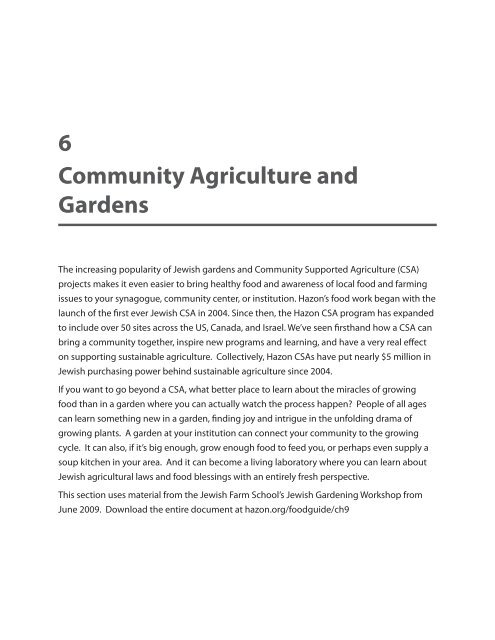
![2011 Israel Sustainable Food Tour Schedule [PDF]. - Hazon](https://img.yumpu.com/50366185/1/190x245/2011-israel-sustainable-food-tour-schedule-pdf-hazon.jpg?quality=85)
